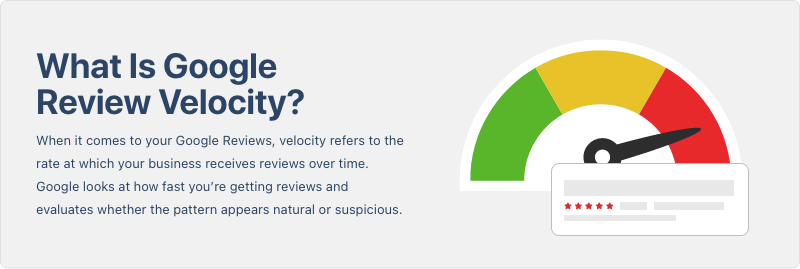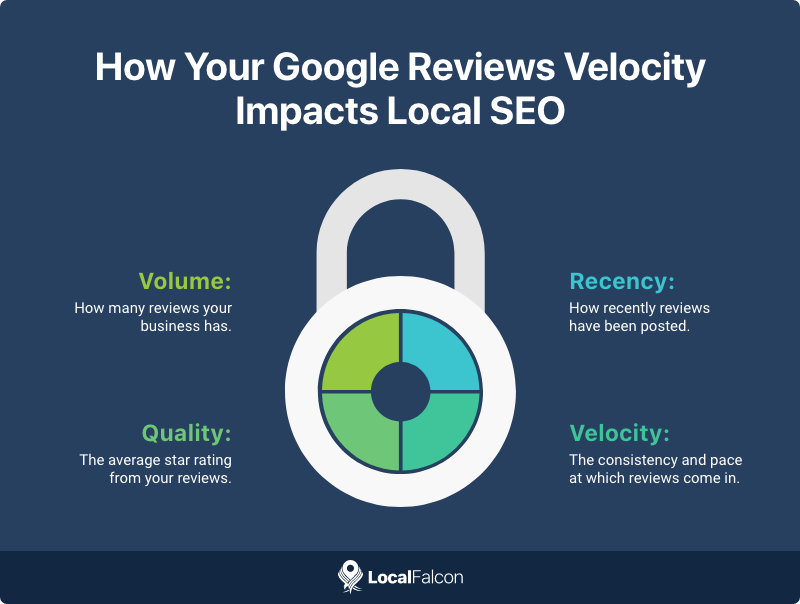Whether you run a local business or manage a Google Business Profile for one, you probably know that Google Reviews are good, and that the more positive reviews you get, the better your business tends to perform, both in local search and real life.
However, while gathering a bunch of positive Google Reviews is important, it's not everything. In fact, if you collect too many good reviews all at once, it can potentially even hurt your local SEO performance. Why? Because of a little something called review velocity.

What Is Google Review Velocity and Why Should You Care?
When it comes to your Google Reviews, velocity refers to the rate at which your business receives reviews over time. Google looks at how fast you're getting reviews and evaluates whether the pattern appears natural or suspicious.
While there's technically no limit to how many Google Reviews you can get in a day or any other period of time, a sudden influx could potentially cause Google to flag your profile or lower its ranking because of what it sees as a bad review velocity.
For example, if your business normally gets only one or two reviews per month, then suddenly receives 50 in a single day, that spike can raise red flags. Google's algorithms may interpret it as inorganic behavior, possibly indicative of buying fake reviews or incentivizing reviews, both of which go against Google's review guidelines.

How Your Google Reviews Velocity Impacts Local SEO
Google considers four key factors when evaluating your reviews for local ranking purposes:
- Volume: How many reviews your business has.
- Quality: The average star rating from your reviews.
- Recency: How recently reviews have been posted.
- Velocity: The consistency and pace at which reviews come in.
A steady, ongoing stream of mostly positive reviews shows Google that your business is active, trusted, and relevant to customers now, rather than just at some point in the past. Google rewards businesses that show slow and steady growth (good review recency and velocity) with better rankings in local search results.
Additionally, as we discussed above, review velocity helps Google determine whether your review profile looks natural or not. Consistent growth builds trust with Google, not to mention potential customers, whereas a sudden surge followed by silence can look artificial or manipulative.
To illustrate our point, let's say Business A gets 3-5 reviews per week, every week, while Business B gets 75 reviews in a single week, then nothing for the next 6 months. Which business do you think Google favors?
The answer is Business A, because it shows steady, organic review activity. On the other hand, even though Business B might get a whole bunch of positive reviews within a short period of time, significantly increasing its review quantity and average star rating, its review velocity is bad in the eyes of Google because there's no consistent activity after that. So, Business A is more likely to rank better in local search, especially in the long run.
How To Improve Your Review Velocity (Without Hurting Your Rankings)
There's no magic mathematical formula for improving your Google Reviews velocity, but the key is consistency. So, rather than getting a ton of reviews in bursts, you want to try and stagger them out relatively evenly over time.
For example, instead of emailing 1,000 past clients to ask them all for reviews in one shot, a smarter strategy is to stagger your outreach. For example, send 20 or 30 review requests per week. Even if only a handful of those past customers actually leave a review, this keeps your review velocity steady over time and avoids raising suspicions from Google's algorithms.
If you're using a review request tool or CRM to ask customers for reviews, look for scheduling or automation features that let you drip out messages gradually. This makes it easier to maintain a healthy, sustainable review flow, and in turn a good review velocity in the eyes of Google.
Think of maintaining a good Google Reviews velocity like watering a plant: you want to give it consistent care, not dump a bucket of water on it once and hope for the best.
Not only will this approach improve your local SEO, there's also the added bonus that it's a lot easier to respond to reviews if you get them at a steady rate, making it less overwhelming to keep up with this other review management best practice.
Final Thoughts
Google Reviews are a powerful part of your local SEO strategy, but more isn't always better, at least not all at once. A steady stream of honest, high-quality reviews over time will help improve your long-term visibility in the local pack as well as build more trust with potential customers.
Now that you understand how to more effectively manage your review velocity, you can make your reputation-building efforts work smarter, not harder.
Lastly, if you're wondering what to do with all that review feedback once you have it, give Local Falcon's Reviews Analysis tool a try!
Our Reviews Analysis Reports analyze sentiment across all your Google Reviews (and those of your top competitors) at once, providing you with virtually instant AI-powered insights into exactly how customers feel about your business.
These reports also contain a review velocity score to help you evaluate whether you have good or bad Google Reviews velocity.
Use review analysis insights to implement business and reputation management strategies that improve your review volume, quality, recency, and velocity over time, further boosting your local SEO success!

